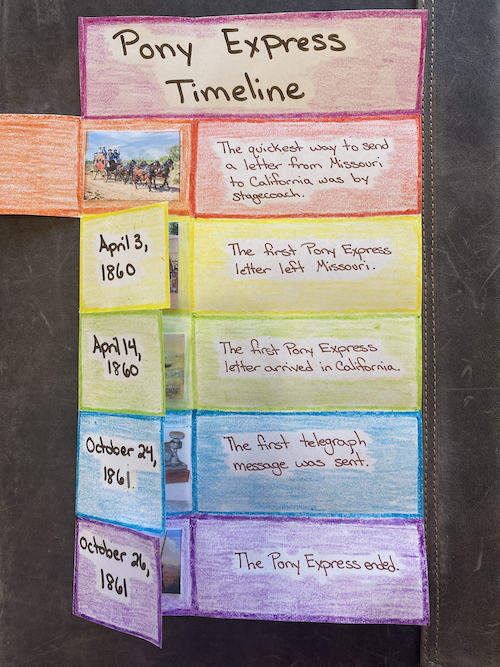Horse and Rider: The Pony Express (Grades 3-5)
Students investigate the importance of the Pony Express to the settlement and expansion of the American West by mapping Pony Express stations.

Background
Lesson Activities
Recommended Companion Resources
Credits
Author
Debra Spielmaker and Lynn Wallin | National Center for Agricultural Literacy (NCAL)
Acknowledgements
Pony Express Horse Breeds Cards Photo Credits:
- "Wild Mustang horses" by Carol M Highsmith is marked with CC0 1.0
- By Ealdgyth - Own work, CC BY-SA 3.0
- By Laura Behning - Silver Morgan, CC BY 2.0
- Morgan Horses
- Thoroughbred Horses
Sources
- http://auto.howstuffworks.com/horsepower.htm
- https://www.history.com/news/10-things-you-may-not-know-about-the-pony-express
- https://nationalponyexpress.org/historic-pony-express-trail/founders/
- https://www.nps.gov/poex/index.htm
- https://www.nps.gov/poex/planyourvisit/upload/National-Park-Service-Large-Print-Text-of-Pony-Express-Brochure-508.pdf
- https://www.asanet.org/sites/default/files/savvy/documents/students/docs/FINAL%20C3%20Fact%20Sheet%209-13-13-1.pdf
Pony Express Station Map:
- https://www.nps.gov/parkhistory/online_books/poex/hrs/hrs6a.htm
- https://www.legendsofamerica.com/pony-express-division-three/#wyoming
- http://twainsgeography.com/content/cottonwood-springs-station
- https://bscottholmes.com/content/deer-creek-station-wyoming-pony-express
- https://expeditionutah.com/featured-trails/pony-express-trail/wyoming-pony-express-stations/
Standards
Texas Content Area Standards
-
Social Studies: 3.113.14.c.4
Geography. The student understands the concepts of location, distance, and direction on maps and globes. The student is expected to:
- Social Studies: 3.113.14.c.14.D: interpret and create visuals, including graphs, charts, tables, timelines, illustrations, and maps
-
Social Studies: 3.113.14.c.15
Social studies skills. The student communicates in written, oral, and visual forms. The student is expected to:
- Social Studies: 3.113.14.c.15.D: express ideas orally based on knowledge and experiences
-
Social Studies: 3.113.14.c.16
Social studies skills. The student uses problem-solving and decision-making skills, working independently and with others. The student is expected to:
- Social Studies: 3.113.14.c.16.B: use problem-solving and decision-making processes to identify a problem, gather information, list and consider options, consider advantages and disadvantages, choose and implement a solution, and evaluate the effectiveness of the solution
-
Social Studies: 4.113.15.c.21
Social studies skills. The student communicates in written, oral, and visual forms. The student is expected to:
- Social Studies: 4.113.15.c.21.C: express ideas orally based on research and experiences
- Social Studies: 4.113.15.c.21.D: create written and visual material such as journal entries, reports, graphic organizers, outlines, and bibliographies
-
Social Studies: 4.113.15.c.22
Social studies skills. The student uses problem-solving and decision-making skills, working independently and with others. The student is expected to:
- Social Studies: 4.113.15.c.22.B: use problem-solving and decision-making processes to identify a problem, gather information, list and consider options, consider advantages and disadvantages, choose and implement a solution, and evaluate the effectiveness of the solution
-
Social Studies: 5.113.16.c.25
Social studies skills. The student communicates in written, oral, and visual forms. The student is expected to:
- Social Studies: 5.113.16.c.25.C: express ideas orally based on research and experiences
- Social Studies: 5.113.16.c.25.D: create written and visual material such as journal entries, reports, graphic organizers, outlines, and bibliographies
-
Social Studies: 5.113.16.c.26
Social studies skills. The student uses problem-solving and decision-making skills, working independently and with others. The student is expected to:
- Social Studies: 5.113.16.c.26.B: use problem-solving and decision-making processes to identify a problem, gather information, list and consider options, consider advantages and disadvantages, choose and implement a solution, and evaluate the effectiveness of the solution
-
Technology Applications: 126.8.c.1
Computational thinking--foundations. The student explores the core concepts of computational thinking, a set of problem-solving processes that involve decomposition, pattern recognition, abstraction, and algorithms. The student is expected to:
- Technology Applications: 126.8.c.1.C: develop a plan collaboratively and document a plan that outlines specific steps taken to complete a project
-
Technology Applications: 126.9.c.1
Computational thinking--foundations. The student explores the core concepts of computational thinking, a set of problem-solving processes that involve decomposition, pattern recognition, abstraction, and algorithms. The student is expected to:
- Technology Applications: 126.9.c.1.C: communicate design plans and solutions using a variety of options
 Write the following dates on the board. Ask the students, "What is the significance of each date?" Rewatch the video if needed.
Write the following dates on the board. Ask the students, "What is the significance of each date?" Rewatch the video if needed.